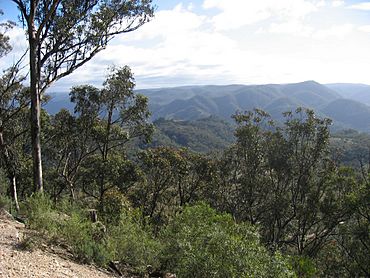Nattai National Park facts for kids
Quick facts for kids Nattai National ParkNew South Wales |
|
|---|---|
|
IUCN Category II (National Park)
|
|

Nattai National Park, from Wollondilly lookout.
|
|
| Nearest town or city | Oakdale |
| Established | 13 December 1991 |
| Area | 489.84 km2 (189.1 sq mi) |
| Visitation | 1,000 (in 1997) |
| Managing authorities | NSW National Parks and Wildlife Service |
| Website | Nattai National Park |
| See also | Protected areas of New South Wales |
The Nattai National Park is a special protected area, like a big nature reserve, in New South Wales, Australia. It covers about 48,984 hectares (that's over 480 square kilometers!). The park is located about 150 kilometers southwest of Sydney. It mainly protects the beautiful valley of the Nattai River, which is surrounded by amazing sandstone cliffs.
The park is mostly covered in dry sclerophyll forest, which means it has trees and plants with hard, tough leaves, like eucalypt trees. Forest fires happen quite often here. Nattai National Park is mostly untouched wilderness. Not many people visit because it doesn't have many facilities and is quite remote, even though it's not too far from Sydney.
Nattai National Park is one of eight protected areas that became part of the UNESCO World Heritage-listed Greater Blue Mountains Area in 2000. It's the most southern park in this World Heritage Site. The park is also part of the Great Dividing Range, a long chain of mountains in Australia.
The park is surrounded by other protected areas. To the north, it borders the Nattai State Conservation Area and Lake Burragorang. To the east, it's next to the Bargo State Conservation Area. To the south, you'll find the Wombeyan Caves Road, and to the southwest, it meets the Kanangra-Boyd National Park. The park also includes parts of the Little, Nattai, Allum, and Wollondilly rivers.
Contents
History of Nattai National Park
The Nattai National Park area has not been greatly changed by people from Europe. Some of the first explorers trying to cross the Blue Mountains passed through this area in the late 1700s. Later, settlers started living in the lower Nattai and Burragorang Valleys around 1827.
Early nature lovers, Myles Dunphy and Herb Gallop, enjoyed bushwalking in this region starting in 1912. They especially loved a forest of Sydney blue gum trees near Blue Gum Creek. When Myles Dunphy found out there were plans to cut down these trees, he tried to save them, but he wasn't successful. The trees were logged in the 1920s and 30s.
In 1932, Dunphy suggested a plan for a much larger "Greater Blue Mountains National Park." This plan included what is now Nattai National Park in the southeast. The building of Warragamba Dam in 1960 made it harder to develop land upstream. However, it wasn't until 1991 that plans to permanently protect the area as a national park finally came true.
Visiting Nattai National Park
You can get to Nattai National Park using Wattle Ridge Fire Road, which is northeast of the small town of Hill Top. This road is unsealed, but you usually don't need a four-wheel-drive car to reach the small car park at the park's edge.
There are no special facilities at the park entrance, just an information board and a logbook. It's very important to sign in when you enter the park and sign out when you leave. This helps park rangers know who is in the park and if anyone needs help. You can also access the park from the Wombeyan Caves Road.
Activities in the Park
Bushwalking Adventures
Nattai National Park offers some great bushwalks, but it's a remote and often dry area. You can camp anywhere outside the Lake Burragorang exclusion zone. Remember not to damage any plants. Choose a campsite carefully and use tents that don't take up too much space.
If you visit the Mittagong information center, try to find a yellow book about walks in the Nattai area. It was published in 1998, but it's a very helpful guide for this quiet and isolated park.
In summer, walking along the fire roads can be extremely hot. It can also be too hot to stay inside a tent at campsites until late in the evening.
Staying Safe While Hiking
Water can be hard to find away from the Nattai River and its smaller creeks. Since this area is quite remote and not many people hike here, it's very important to tell someone responsible your plans before you go. You might also want to consider taking an EPIRB, which is a device that can send a distress signal if you get into trouble.
Mobile phones might work on the highest parts of the plateau around the valley, but they usually won't work down in the valley itself. Make sure you are good at reading maps and finding your way. After fires, the undergrowth can clear out, making it hard to find faint trails.
Be careful of snakes, especially when they are warming themselves on fire roads or trails, or near creeks. They might not always move away when you get close. Red-bellied Black Snakes are the most common type you might see. Always carry snake bandages and know how to use them.
It's a good idea to treat any water you take from rivers or creeks. There are towns upstream, so the water might contain germs like Giardia. Also, after heavy rain, there can be many thorny vines, spiky plants, and stinging nettles near the river. It's best to wear clothes that protect your legs and hands in these conditions. You might also see many wombat burrows and areas where wombats have dug up the soil.
Climbing
There are opportunities for climbing in the park, but specific details are not widely available.
See also
 In Spanish: Parque nacional Nattai para niños
In Spanish: Parque nacional Nattai para niños


